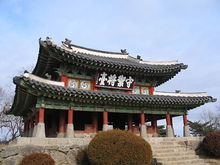- Namhansanseong
-
Namhansanseong 
Sueojangdae(Sueojangdae command post)Korean name Hangul 남한산성 Hanja 南漢山城 Revised Romanization Namhansanseong McCune–Reischauer Namhansansŏng Namhansanseong (literally "South Han Mountain Fortress") is a park at an elevation of 480m above sea level, immediately to the southeast of Seoul. It is located on Namhansan ("South Han Mountain"). It contains fortifications that date to the 17th century, and a number of temples.
Contents
Early history
Tradition connects the site of Namhansanseong with Onjo, founder of Baekje. In 672, a fortress called Jujangseong (晝長城) was built on the western edge of Namhansan to protect Silla from Tang China. Later the fortress was renamed Iljangseong (日長城). Goryeo kings kept the fortress in repair as a defensive outpost for Gwangju, the nearby provincial capital.
Most of the fortress that exists today dates from the Joseon period. The construction was planned Seo, beginning in 1624, when the Manchus were threatening Ming China. In 1636, the Manchus invaded and King Injo fled with his court and 13,800 soldiers to Namhansanseong. Here they were well defended and the king enjoyed the protection of a bodyguard composed of 3000 fighting monks. The Manchus were not able to take the fortress by storm, but after 45 days of siege the food supply inside ran out, and the king was forced to surrender, giving his sons as hostages and shifting allegiance from the Ming. The Samjeondo Monument (三田渡碑) was erected on the southern route from Seoul to Namhansanseong to mark this event.
After the Manchus withdrew, Namhanseong remained untouched until the reign of King Sukjong, who enlarged it and added Pongamseong on the northeast corner of the fortress area in 1686. Another annex, Hanbongseong, was built along the ridge east of the fortress in 1693. More work was done in the reign of King Yeongjo (1724-76). The grey brick parapets date from 1778, during the reign of King Jeongjo.
Namhansanseong Provincial Park
The fortress went unused and slowly crumbled until 1954, when it was designated a national park and a good deal of repair work was done. The fortress area once accommodated nine temples, as well as various command posts and watch towers. Today a single command post, Seojangdae (西將台), and a single temple, Changgyeongsa, remain. There are other more recent temples on the path up to the south gate and fortress walls. The north, south and east gates have been restored.
Seojangdae is where Injo stayed during the Manchu siege of 1636. The building's second story was added in 1751, at which time the pavilion received another name, Mumangnu (無忘樓), meaning "Unforgotten Tower". This name apparently refers to the unforgettable shame of the surrender to the Manchus. The shrine of Chonggyedang dates from the same period, and was constructed in honour of Yi Hoe, who was wrongfully executed for his responsibilities in constructing of the southern part of Namhansanseong.
A number of less important historical, sites such as Sungnyeoljeon (崇烈殿, erected in 1638) and Chimgwajeong are associated with the ancient Baekje ruler Onjo. Not far from the western wall was the site of Songsu-tap (頌壽塔), a tower with a metal phoenix on top, erected to commemorate President Syngman Rhee's 80th birthday in 1955. When the Rhee government was overthrown in the 1960 Student Revolution, the monument was destroyed.It caught on fire on 2/11/08.
See also
- History of Korea
- Castles in Korea
- Hwaseong Fortress
External links
World Heritage Sites in South Korea World Heritage Sites Changdeokgung Palace Complex · Gochang, Hwasun and Ganghwa Dolmen Sites · Gyeongju Historic Areas · Haeinsa Temple Janggyeong Panjeon, the Depositories for the Tripitaka Koreana Woodblocks · Historic Villages of Korea: Hahoe and Yangdong · Hwaseong Fortress · Jeju Volcanic Island and Lava Tubes · Jongmyo Shrine · Royal Tombs of the Joseon Dynasty · Seokguram Grotto and Bulguksa Temple
Tentative Lists Ancient Mountain Fortresses in Central Korea · Daegokcheon Stream Petroglyphs · Gangjingun Kiln Sites · Gongju and Buyeo Historic Sites · Iksan Historic Areas · Mt. Soraksan Nature Reserve · Naganeupseong, Town Fortress and Village · Namhansanseong - Ancient Fortified Military and Cultural Landscape of Mt. Namhansan · Oeam Village · Salterns · Sites of fossilized dinosaurs across the southern South Korean coast · Southwestern Coast Tidal Flats · Upo wetlandCategories:- Castles in South Korea
- Visitor attractions in South Korea
- History of Seoul
Wikimedia Foundation. 2010.

